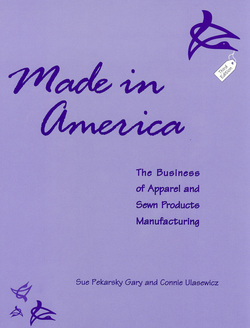MADE IN AMERICA: THE BUSINESS OF SEWN PRODUCTS MANUFACTURING

Prologue
Designs and creativity drive the fashion and textile entrepreneur to produce a wearable, usable, salable expression of initial ideas. The business itself is down and dirty, and one’s product is in constant peril of either appearing passé or being “knocked off”—copied. Consequently, in writing our book, we know we are speaking to creative people. You need every bit of relevant information we can give you so that you can operate competitively in the arenas of garment, textile, sewn products and home furnishings designing and manufacturing.
Our experience is as designers and artists for over thirty years, garment manufacturers for a total of twelve years and garment industry consultants and teachers of fashion studies curricula at California colleges for a total of twelve years. We have successfully turned our fashion design ideas into profitable ventures in the rag business. As teachers, writers and consultants we have been effectively imparting information for many years by offering popular courses and seminars.
This book presents how-to material geared to all you creative people—a population most worthy of making money from your ideas. This concise handbook provides easy access to an excellent overview of the business—no matter in what part of the country or world you live.
Introduction
Positive reception of your design ideas has caused you to consider producing or manufacturing them for a greater exposure in and share of the market place. The design—your design—is the driving force behind your consideration of manufacturing as a means to recognition and financial success. Design-based manufacturing is the term we use to identify production in quantity of a product that you have designed.
Designing may come easily to you. It is also satisfying to create and then to receive positive feedback on your creations. But, taking the leap to being a manufacturer brings you instantly into the demands of “doing business”—another world. Also, your creativity will need to respond to maintaining a company image or look. At the same time, you must have something new each season. Staying au courant and fashion-forward is as important as maintaining a consistent look or image. Suddenly there will be limits to and demands on your creative endeavors. Fitting your ideas to your company’s needs may sometimes be an exhilarating experience and sometimes discouraging.
Entrepreneurship is currently a popular identity. It is an answer to being at the mercies of the job market, downsizing and loss of benefits. Being your own boss, your own person, is appealing to many of us who have lots of ideas, drive and focus. The lure of being captain of the ship or commander of the fleet needs the balancing realities of being head of the company. For all the glory of being at the helm, there are the responsibilities of being in charge of a viable operation. For all the freedom to do what you want, there are the constraints of doing what is necessary to successfully stay in business.
In addition to being clever and in control, you must be organized and flexible. You need to be able to do many tasks and delegate responsibilities as necessary. You need to be goal-directed and to identify all the little steps to the goal, to see the big picture and to pay attention to details. In design-based garment, textile or associated industries and in craft manufacturing you will wear many hats. On any one day you may be designer, marketing director, sales manager, production manager, chief financial officer, quality control inspector and shipping clerk. You may use a variety of sales venues such as “brick and mortar” stores, catalogs, e-commerce and trade shows. If you find this daily variety appealing, then entrepreneurship as a design-based manufacturer is definitely something for you to consider.
Table of Contents
Chapter 1: Evaluating Your Skills and Product for Development
Chapter 2: Defining the Image and Form of Your Company/Product
Chapter 3: Product Design
Chapter 4: Costing
Chapter 5: Sales and Promotion Tools for Selling Your Product
Chapter 6: Producing Your Product
Chapter 7: Product Distribution, Management and Payment
Final Analysis
Appendix A: Sources
Appendix B: Business Plan
Appendix C: Forms
Purchase
Back to Publications
